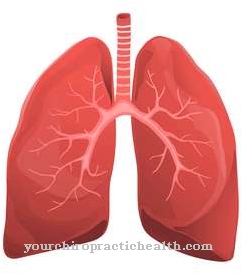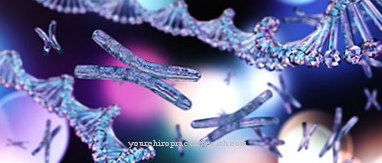There are only a few terms that have been misinterpreted and reinterpreted more often and caused more discussion than the hysteria. The term used by the famous ancient doctors Hippocrates and Galen has a completely different meaning today and is better researched than two and a half thousand years ago. But there is still a lot of work to be done for scientists and psychologists.
What is hysteria?

© Wayhome Studio - stock.adobe.com
hysteria derives from the ancient Greek word for uterus, "hystera", and nowadays describes a conspicuous, extremely extroverted behavior that is triggered by a mental disorder.
Today, a distinction is made between two groups of symptoms: conversion disorders and dissociative disorders. The former are traumatic experiences which the mind cannot process and which are therefore "converted" into physical complaints. The dissociative disorders have the same trigger, but are expressed in disorders of consciousness.
In ancient times - and for a long time afterwards - the cause of the disease was not assumed to be in the brain but in the uterus and was therefore exclusively attributed to women. Famous physicians like Hippocrates, for example, assumed that the symptoms were triggered by the migration of the uterus to other organs. Therefore, to treat hysteria, they prescribed intercourse and pregnancy to get the uterus back in place.
causes
Even if the causes for a hysteria are still not fully clarified, it is now assumed that the development occurs in early childhood, between the ages of 4 and 6.
During this time, the researchers see an enormously important step in the child's development, both physically and psychologically. At this point in time, the child has already acquired many motor and mental abilities, but is faced with the problem of beginning integration into the adult world.
If in this phase there is a lack of strong role models who make this new and unknown world seem interesting to her - for example, if a parent or other important caregiver is missing - this can lead to the development of hysteria.
Symptoms, ailments & signs
A sign of hysteria in the sense of histrionic personality disorder is a strong desire for attention. This need is met through various means. According to Alarcon (1973), seven central features of hysteria can be distinguished.
One of them is theatrical behavior. Histrionic personalities tend to exaggerate and often stage themselves to arouse sympathy or to put themselves in the foreground.
Another symptom of hysteria is emotional instability. Histrionic personalities often experience drastic mood swings, with the individual feelings usually being very pronounced. This can make them appear moody and unpredictable. The feelings shown do not always match the situation; they can also be socially inappropriate.
Another sign of hysteria is that those affected voluntarily become dependent on one or more other people. However, they do not completely subordinate themselves. This often creates a paradoxical situation in which the histrionic personality on the one hand wants to make self-determined decisions and on the other is looking for someone to look after them like a child.
Overreactions, egocentrism and susceptibility to influence are other symptoms that are typical of hysteria. The influence can not only come from others, but also from the histrionic personality himself. In addition, many histrionic personalities behave in a sexually seductive manner in order to arouse attention and admiration in this way as well.
Diagnosis & course
The biggest problem in diagnosing one hysteria is the classification of symptoms, be they psychological or physical in nature, as a consequence of this. If, for example, visual disturbances or symptoms of paralysis occur, the causes are usually first looked for in other areas.
It is similar with disturbances of consciousness, which can also occur as a result of many other diseases of the central nervous system. Misdiagnosis is therefore quite common and difficult to avoid. A diagnosis can only be made reliably by an experienced therapist who is familiar with the field of hysteria.
Complications
Psychiatry understands the actually outdated term hysteria as a neurotic disorder.This goes hand in hand with unstable and superficial affects, a need for recognition, manipulative behavior and a pronounced need for recognition. Today we speak more of conversion disorder or histrionic personality disorder.
This explains why there can be complications associated with these behaviors, especially with the environment. Affected people demand excessive attention, are subject to unpredictable emotional fluctuations and push themselves to the fore. Other people usually find this annoying and keep their distance.
This is especially true if you see through the manipulation techniques hidden behind it. Above all, people with histrionic personality disorder cannot understand this reaction and reinforce the strategies they learned at an early stage, which creates a vicious cycle. As a result, patients with a tendency to hysteria are either often marginalized or sometimes find others who are codependent.
However, this is also unfavorable for the therapeutic process. Stable, healthy relationships are very difficult for those affected to establish. Since these are behavioral patterns whose roots go back to childhood, they are difficult to influence therapeutically. They are deeply anchored in the personality of those affected. The therapeutic process is lengthy and tough. Even experienced therapists have to be careful not to get caught up in them.
When should you go to the doctor?
There is no longer a diagnosis with the term hysteria because it is an old term. Nevertheless, a doctor should be consulted as soon as the symptoms associated with the expression arise. Behavior that, in direct comparison to other people, is perceived as above the norm should be professionally assessed by a doctor.
A particularly aggressive appearance or self-endangering behavior are reasons for a doctor's visit. There are worrying states of experience in which the person concerned overreacts severely emotionally, can no longer fulfill his everyday duties and his usual level of performance is no longer achieved. Apathy, sexual abnormalities, or memory loss should be investigated and treated.
Wrong memories or gaps in memory are unusual and can also indicate organic problems. In these cases, medical examinations must therefore be initiated as soon as possible. If sensitivity disorders or changes in personality occur, a doctor should be consulted. A strong experience of fear, the loss of reference to reality or very selfish behavior are indications of existing disorders.
A visit to the doctor is necessary to prevent further deterioration in health. With a mental illness, there is often a lack of insight into the illness. This is one of the symptoms and should be taken into account accordingly. A good relationship of trust with caregivers and the doctor are of particular importance.
Doctors & therapists in your area
Treatment & Therapy
Also treating a hysteria is not exactly simple and cannot be carried out according to a fixed scheme. Rather, the therapist must specifically address the subjective disorders - and their causes - of each individual patient.
Above all, it is necessary to find out in numerous sessions what is causing the respective symptoms and then to look closely at which psychoanalytical approaches are most likely to achieve an improvement. Due to the often very possessive and engaging nature of hysteria, therapy in most cases proves to be very tedious and difficult to carry out.
You can find your medication here
➔ Medicines to calm down and strengthen nervesprevention
Because of the not yet fully explored triggers for a hysteria, their possible prevention is not yet really clear either.
A sheltered home and a solid social environment during early childhood could - based on the current state of research - counteract psychological repressions and the hysteria that may result from it.
Since the causes and the starting point of hysteria are better known today and the ancient ideas have been largely refuted as a result, new terms such as dissociative disorder or histrionic personality disorder have become common in medicine. The exact reasons, however, are still partly unclear and thus make treatment more difficult.
You can do that yourself
Hysteria is an outdated term for a mental disorder. Since it is very imprecise, the possibilities for self-help in everyday life must be assessed individually. In order to obtain a differentiated diagnosis, it is necessary to work with a psychotherapist or psychologist. Subsequently, methods and various individual behavioral techniques for self-help can be determined together.
Generally speaking, the affected person shows an occurrence deviating from the norm that he cannot adequately regulate himself. The mental illness leads to the fact that the patient is not aware of his own behavior. As a result, the self-regulation measures are very small. Some sick people pose a risk for themselves and others. Despite being informed, there is a lack of insight into the disease and one's own occurrence cannot be controlled.
In many cases, the relatives and people in the immediate environment are strongly influenced by the mental disorder in their way of life. You are advised to find out more about the symptoms of the disease. This improves interaction with one another and promotes mutual understanding. An emotional demarcation is made easier and the sensitivity for a necessary intervention is learned. In many cases, the sick people cannot cope with everyday life without outside help. They are dependent on support and need caregivers they can trust.






.jpg)





















